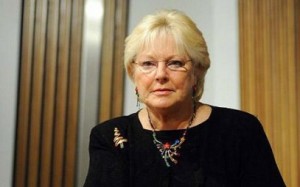Kenneth MacAlpin (843-859)

Kenneth MacAlpin
The story we commonly hear is that Kenneth MacAlpin is one Scotland’s great heroes. The champion who is AD 840 is supposed to have driven off the Vikings. This brave war leader appears to have come from nowhere stepping into the power vacuum created after the existing Royal line is massacred by the Vikings. So it is that Kenneth MacAlpin steps in and unifies Scotland and is famously crowned the First King of Scotland.
But this idea that Kenneth MacAlpin (Cináed mac Ailpín) is the First King of Scotland is a myth. The historical records tell a different story.

5 separate groups of people
In the time of Kenneth MacAlpin, Scotland did not exist. It was 5 separate peoples; The Angles, The Vikings, The Gaels, The Britons and The Picts. Each retained their own distinctive culture. Records tell us that Kenneth MacAlpin was described as King of Pictland, not King of Scotland. It’s not until 40 years after Kenneth dies that we find the first mention of ‘The Kings of Scotland’.
The Northern Isles bore the brunt of the worst Viking invasions, as well as smash and grab raids where treasure was stolen, as well as people who were taken and sold as slaves, the Vikings colonised parts of the British isles including the Hebrides. On Orkey and Shetland it is believed they exterminated the Pictish men, a 9th Century version of ethnic cleansing. In the terror of the Viking raids the Pictish Kingship was almost completely destroyed in 839AD.
There are very little known facts we know about Kenneth MacAlpin. He was born around 800AD in the Gaelic Kingdom of Dál Riata at a time when the Gaels were dominated by the more powerful Pictish kingdom. His father, Ailpín, was beheaded fighting for a Pictish king and historical sources suggest that his mother was a Pictish princess.
Kenneth MacAlpin becomes the King of the Picts, nearly everyone else who could have been considered for Kingship had been killed by Viking raids. Also there are some accounts which alude to Kenneth killing Pict rivals for the throne though these accounts are of dubious origin.
It was dangerous times, a Viking fleet of 140 ships intent on destruction attacked Dál Riata (the Gaelic Kingdom). The Gaels moved all of their treasure and relics of their Saints to Kenneth’s new Pictish Kingdom which under Kenneth MacAlpin was better defended. The outcome of this can easily be presumed as Dál Riata vanishes from the chronicles and we only hear of Pictland from this point. So Kenneth is King of this new unified Kingdoms of the Picts and the Gaels.
Kenneth is able to reward his Gaelic followers with lands taken from the men who supported his rivals. So the Picts and the Gaels become more integrated, although imagine there was much resentment at the time. Kenneth began to raid Northumbria for booty to build his new unified Kingdom.
Kenneth MacAlpin died in 858 at Cinnbelachoir, a place believed to be neat Scone The Gaels are recorded to have lamented his passing: ”That Kenneth with his host is no more brings weeping to every home. No king of his worth under heaven is there, to the bounds of Rome.”. It is not known what The Picts felt. It was their way of life that was vanishing, they must have believed that Kenneth’s ancestors would have adopted Pictish ways but as history tells us this is not what happened. With King Constantine II it is apparent, it is the Picts who end up vanishing from history.
Kenneth MacAlpin was the founder of a new dynasty, a dynasty that united the Pictish and Gaelic kingdoms to become the new Kingdom of Alba. Kenneth MacAlpin has an undisputed legacy; If he cannot be regarded as the father of Scotland, he was the founder of the dynasty which ruled that country for much of the medieval period. From here the Kingdom of Scotland grew.
Related Blog Posts to Kenneth MacAlpin

Campaign to Return Scotland’s Birth Certificate
Read More





